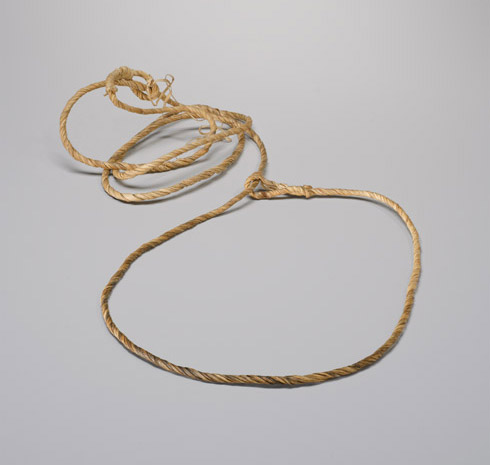About the Artifact

© Canadian Museum of Civilization, VI-I- 27, Photo Marie-Louise Deruaz, IMG2010-0112-0002-Dm
-
“Caribou were often caught in snares twisted from six strands of caribou babiche. More would prevent its drawing tight. The snare is set with the bottom of the loop about two feet [60 cm] above the ground, and the opening in it is roughly two feet [60 cm] wide and three feet [90 cm] high. It is tied at the four corners to willows with wisps of grass that will break easily. Bull caribou insert their antlers carefully in the loop without realizing that it is a snare. Bulls fight much more than cows when snared. A quick stab in the heart with a caribou spear will finish any found alive. Some men will put out ten or more snares and run them as a trap line. They are used only in cold weather when the meat will keep well. A strong bull will sometimes break a snare.”
— Douglas Leechman, 1954
-
“They used nothing but [a] bow and arrows, and snares … in the wintertime, they made fences with trees, brush, things like that, and then they set lots of snares … [They drove] a big bunch of caribou in those snares …Babiche snares, that was all they used. I think one caribou skin made one snare … they twisted it and twisted it, oh, maybe six, seven, eight. And then they twisted them again and tied them to a pole and stretched them.
Sometimes [the caribou got choked in the snares]. After they went in the fence, those caribou were alive. They had long spears, bone spears, on the end of a long stick. They stabbed them here someplace and that’s how they killed them in the snares. Then they threw them over the fence … They threw them over the fence right away and reset the snares in case there’s another bunch coming …”
— Moses Tizya, Vuntut Gwitchin Elder, 1977
(Vuntut Gwitchin First Nation Collection VG2001-04-06:31-283)
-
“[A] corral was built mainly by one family, who … maintained it. The head of the family, the ‘captain of the corral’, was called Dinjii chit, same as camp boss …When a hunt was planned, some young men were sent … to bring the caribou in. They were not to panic or stampede the herd but to bring it in steadily and gradually, not alarming it.
… They were known for their ability as herders. Because this is done to make a living … This was [a] long time ago, and the people believed in medicine. That is the way they worked with one another. So they had to pick good people …
There’s always someone that’s the headman. All these corrals — the one on the Rat River, the one over at La Pierre House, Driftwood River and Cache Creek — they all got a name. They named them by the captain of the corral …
Whoever the captain is, in the spring, even before the snow start melting away, they make a camp near this corral, and then they start working on it. If the person had a big family, well his family stay with him. Then his boys or his sons-in-law, or like that, they help him to repair the corral. It takes a long time to repair it because everything got to be packed down by hand. After it’s repaired, it’s ready for the caribou to come …
They get other people to help them do the herding and killing and butchering.
[Question: When the caribou were divided up, did these people (the headman’s family) get the most?]
No — well, it’s up to the captain. If there’s a hundred caribou killed, with ten families, well, he know — I guess he divide them according to the size of the family. This time of the year, the caribou that they get all goes for clothing for the winter. Clothing and also tent. I don’t think that a man with a small family get as much as a one with a big family. Well, it’s always the captain that knows how to handle it.”
— Jim Edward Sittichinli, Ehdiitat Gwich’in Elder, 1966
(Docs Ethno, E2006.7 B795, f.16, CMC Archives)
-
“I have set snares for caribou. Once I was stuck without gun (or ammo), but lots of caribou nearby. I set snares below cutbanks where caribou run down … and caught four. Snare[s] are of babiche, twisted around a central core of babiche when green, and stretched by [stringing between two objects] and leaning a heavy log against it.Rabbits pay no attention to human scent on snares, but moose and caribou do. To remove the scent, hot, charred brushwood is rubbed along the babiche.
When one caribou is snared, the others in the bunch turn back and run another way; so, ordinarily, one gets only one at a time with snares.”
— William Vittrekwa, Teetł’it Gwich’in Elder, 1938–1939 or 1946–1947
(Docs Ethno, E2006.7 B795, f.21, CMC Archives)